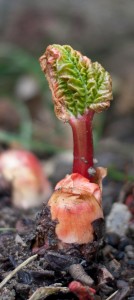This year I have tried to be more organised with regard to my productive garden (as well as my flower garden). I even tried to think about succession planting for once – I know that anyone with an interest in growing their own should do this as a matter of course, but I am not the most organised person and I leave the planning for my day job (or so I tell myself).
This year’s master plan was to sow some dwarf broad beans (var. Sutton) early in the year and hope to harvest them in June. The idea being that this would then make room for my French beans in the small bed at the bottom of the garden. I started them off in February and planted them out at the end of March. They grew quite well (some in the bed, some in a tub) and flowered a lot – as shown in the photo. However, the beans themselves seemed to take an age to grow – I harvested some in the middle of the month, but these were in the tub which still remains empty in the vain hope that I can get a courgette to grow and get a late crop; and the bed remained quite full – see picture below. I finally pulled the rest out last weekend – they were taking over and all of the salad leaves I had planted had gone quite leggy and had mainly been eaten during the damp weather. I planted out some more French beans as I think the prolific foliage of the broad beans had held some of them back, but I had already planted out my aubergines (new for this year for me), tomatoes and courgettes. Therefore, other than the aforementioned beans and some very healthy-looking (i.e. not yet ready to harvest) garlic, I think that it will be some more salad crops for the next month or two in this bed. The sad thing is that the crop of beans was nothing to shout about – there were on average 3 beans per pod and about 4-8 pods per plant – hardly an abundance. I have decided to give broad beans a miss next year.
As you can see from the photo of the bed at the bottom of the garden, my mizuna bolted in the warm May sun (as did the rocket), but I got several salads out of them before I pulled them up. I am not sure if pulling the mizuna up was a cunning plan as it was growing quite well, but was getting leggy. I have some more in pots amongst the tomatoes and courgettes, and some in modules waiting to replace them, so, for the first year ever I think I have had a modicum of success in the realm of salad leaves. I know they are supposed to be easy to grow, but I always seem to kill them off – usually by forgetting to water them.
 On the positive side the soft fruits are having a better year this year. Due to some mis-timed pruning last year we had zero blackcurrants – a fact that James is eternally ashamed of. However, he resisted the temptation to get the secateurs out this year and we were rewarded with about a pound of currants harvested a couple of weeks ago. This is also the second year that we have had the gooseberry (var. Invicta) in the front garden and it is the second year that it appears to have avoided the attentions of sawfly. It seems to enjoy the extra sun and warmth of the front of the house, the crop this year (again harvested a couple of weeks ago) was about 3lb – about three times larger than last year. Not bad considering that when it was in the back garden we never got more than 6 berries!
On the positive side the soft fruits are having a better year this year. Due to some mis-timed pruning last year we had zero blackcurrants – a fact that James is eternally ashamed of. However, he resisted the temptation to get the secateurs out this year and we were rewarded with about a pound of currants harvested a couple of weeks ago. This is also the second year that we have had the gooseberry (var. Invicta) in the front garden and it is the second year that it appears to have avoided the attentions of sawfly. It seems to enjoy the extra sun and warmth of the front of the house, the crop this year (again harvested a couple of weeks ago) was about 3lb – about three times larger than last year. Not bad considering that when it was in the back garden we never got more than 6 berries!






